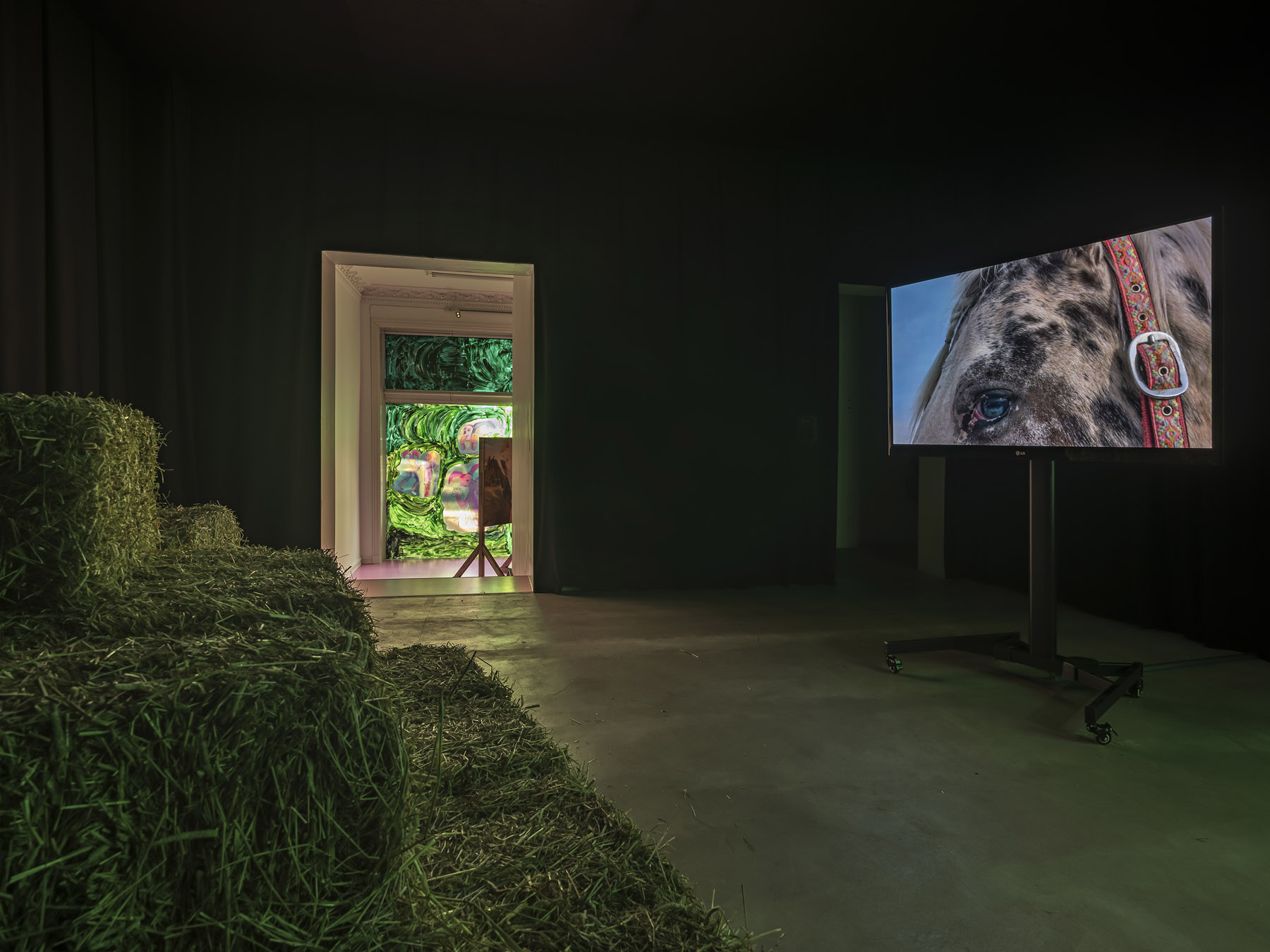Artist: Josefin Arnell
Exhibition title: Wild Filly Story
Curated by: Rhea Dall
Venue: UKS, Oslo, Norway
Date: September 11 – October 18, 2020
Photography: all images copyright and courtesy of the artist and UKS, Oslo
The work of Swedish artist Josefin Arnell (b. 1984) circles around questions of stigma, control, and concealed trauma and, not least, the healing thereof. A contemporary mélange of trashy performativity and pink-hued hysteria, her upbeat and entertaining filmic universe has, over recent years, taken on questions of addiction, mental instability, and (powerless) dependence, focusing on society’s flipside. In one example prompted by personal health problems, Arnell created an opera about the power of tiny ticks and chronic Lyme disease, nicknamed the invisible disease— a looming threat in the Nordic countries. Elsewhere, the artist has worked with her alcoholic mother, in one instance filming her as mother and daughter venture to meet a world-famous Catholic healer in Brazil, as if trying to create a road-movie in reverse, turning back time on a childhood gone wrong.
For this exhibition, Arnell’s first large-scale solo show in Scandinavia, UKS has commissioned a grand new work that takes as its point of departure a therapeutic stable focused on helping youth on the periphery of Amsterdam, the city in which the artist currently resides. The large-scale, three-room installation embraces the viewer in a country- and-western style grandstand, silage, holograms, and the prospects and perils of horse love. The exhibition’s centerpiece is a new film, Wild Filly Story, starring a pack of adolescent girls from the aforementioned stable, playing out a fictionalized script that prompts questions about friendship, being a misfit, normativity, fetishization, and female empowerment. Directed in the manner of a reality TV show, the young girls method-act through stages of agitation, drawing on the artist’s own rural childhood trauma in Sweden and her recent short-lived career as a porn film director: there are teens pulling hair, grand stallions being objectified, food fights, horse healing, and “explicit content” kissing.
A thread through the film is a loose interpretation of a true story from the artist’s own adolescence. At the beginning, a lean, braces-wearing young girl’s horse is taken away to be slaughtered; at the end (though the film loops and thus never ends) the girls and stable community feast on the horse’s meat. Marking the film’s looping beginning and end, a ghost—an emo teen, white-faced, perhaps dead — grimes her way through the “gabber” song “Drop Dead” by underground London musician Astrid Gnosis with the gang of horse girls as her backing choir. Meanwhile other scenes show a couple engaged in clichéd kissing in the hay (“your voice is a bird”, the male mocks, borrowing his words from a series of so-called “poem jeans” by denim magnate Levi’s); and a cowgirl talking about a stallion having its balls cut off, giggling through her characterization of its masculine rage being tamed. Arnell exposes popular culture’s stereotypical binaries of male and female, free versus servile or broken. Through the vision of the vicious teenagers, group dynamics of power and its misuse are pushed forward, lurking just below the surface of society’s supposed therapeutic rooms or safe spaces. These grim dynamics are coupled with an eye hungry for televised entertainment: it’s an underlying rule here that someone’s got to be trashed — a message emphasized on the UKS store front windows, where naïve drawings display mean girls bullying one another. In contrast to the hardcore and humorous fictional realm of Wild Filly Story in UKS’ front spaces, in the back space is a calmer and more soothing documentary that follows Nikita, one of the film’s characters. Here Arnell escapes the script, and her close connections with the women involved are revealed as she slowly gets under the skin of this character and her real-life quest to rescue a previously mishandled horse. The young woman talks through her emotions and the motions of trying to save the animal. This story — revealing the general ethos of the therapy stable towards the teens — makes clear that Arnell’s project is, in the end, an exploration and enactment of the many systemic effects of loss or lack of (human) care.
Josefin Arnell (b. 1984, SE) has recently presented exhibitions, screenings, and performances at Van Abbemuseum, Eindhoven (2019); Lily Robert, Paris (2019); Moscow International Biennale for Young Art (2018); Auto Italia, London (2018); Kunsthalle Münster (2017); and Beursschouwburg, Brussels (2017). Arnell lives and works in Amsterdam. She is a graduate from the Sandberg Instituut in Amsterdam and an alumni of Rijksakademie van beeldende kunsten.
-Text by Rhea Dall


















